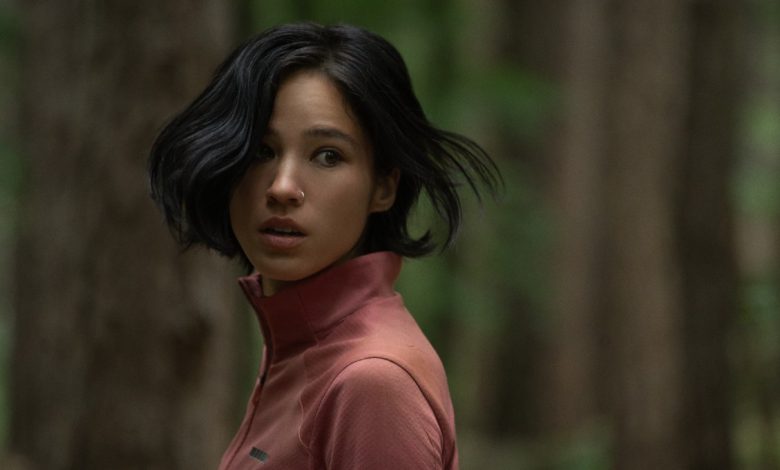‘Don’t Move’ Directors and the Gamble of Their Hit Netflix Survival Thriller

It’s exceedingly rare for a directing duo to come out of the Gopher State. But in the case of Don’t Move’s Adam Schindler and Brian Netto, they had the ultimate example to follow.
As 9-year-old classmates in Woodbury, Minnesota, Schindler and Netto started making backyard movies in their suburban neighborhood just like the Coen brothers had done decades earlier in their nearby Saint Louis Park suburb. As Schindler and Netto focused more and more on their pursuit, they eventually took a page out of the Coens’ co-directing playbook by crediting one person as sole director and the other as a producer. The tale they had heard was that Coens adopted the approach in order to create a more favorable impression among financiers. (After 20 years, the Coens finally shared directing credit as of 2004’s The Ladykillers.)
Schindler and Netto opted for a slight tweak by taking turns, with Netto receiving director credit for their 2013 feature debut, Delivery: The Beast Within, and Schindler for their 2015 follow-up, Intruders. They eventually abandoned the strategy while helming an episode of the Sam Raimi-produced Quibi series, 50 States of Fright (2020). Overall, the short-form streaming platform may have been a resounding misfire, but it introduced Schindler/Netto to Raimi, paving the way for Netflix’s latest success story.
“On 50 States, [Sam Raimi] was so happy with our episode, ‘Grey Cloud Island,’ that we actually had meetings about a spinoff feature of our episode,” Netto tells The Hollywood Reporter.
While their Quibi episode never evolved into a feature, Raimi’s producing partner at Raimi Productions, Zainab Azizi, eventually got a hold of a feature script that Schindler and Netto had developed with their Intruders co-writers T.J. Cimfel and David White. Azizi wasn’t tied to 50 States of Fright, so when she championed Don’t Move to Raimi, he recognized his former collaborators and jumped at the chance to reunite.
“Zainab was so outspoken about making it, and Sam was like, ‘I love those guys. I remember them. Let’s do it.’ Because he saw our work ethic and what we had put together on 50 States, I like to think that it was a large reason why he said yes,” Netto says.
The survival thriller chronicles Yellowstone star Kelsey Asbille’s Iris, whose grief over the accidental death of her young son has led her to the edge of the very same cliff that took his life. Before she jumps, she’s interrupted by a charming stranger named “Richard” (Finn Wittrock), who voluntarily shares how he overcame his own personal tragedy years earlier. Iris then abandons her fateful idea, only Richard has set a trap to abduct her, injecting her with a paralytic agent in order to ease the process. Thus, Iris is immobile for the majority of the cat-and-mouse genre film, and the notion of an utterly helpless protagonist initially created a lot of doubt among the creative team, including Raimi.
“[Raimi] told us that he wasn’t quite sure if a [temporarily] paralyzed main character was going to work. He was like, ‘I was a little nervous,’” Schindler shares. “He also came out to Bulgaria for a good week, and after a few days of watching our approach [on set], I think he felt more confident.”
The film was made independently before Netflix acquired it following a distributor screening. The streaming giant is a fitting home since Sarah Sarandos, the daughter of Netflix co-CEO Ted Sarandos, actively produced the film. But, despite Sarandos’ early awareness of his daughter’s solo effort, he made a point to not give his acquisition team a heads-up so that the film could sink or swim all on its own. (It has since reigned atop Netflix’s global film chart from Oct. 21 to Nov. 3.)
“He kept everything quiet. He let his team look at it and judge it on their own merits. After they screened it, they told [Ted Sarandos], ‘We like this. We want to get it,’ and he was like, ‘Oh, I’m aware of it. I’ve seen it. I understand,’” Netto says. “So I think it was all to make sure that [Don’t Move] felt as though it was not in any way tied to Netflix prior to the [distributor] screening, because there were other interested suitors at that screening.”
Below, during a recent conversation with THR, Schindler and Netto discuss the particulars of Asbille’s challenging physical performance, as well as the personal reason for why they want to bring Miles Morales’ Spider-Man into live-action for the first time.
***
If topping Netflix’s global film chart is the culmination of your story so far, what’s the humble beginning?
ADAM SCHINDLER Brian and I have known each other since we were 9 years old. We met in the back of a fourth grade classroom. We bonded over comic books, whatever was on TV and whatever cool movie we had just seen. This was in a suburb outside of Saint Paul, Minnesota, called Woodbury. Then, in probably fifth or sixth grade, we picked up a camcorder. We were bored enough to start shooting little movies in the backyard for fun, and I’m sure our parents were like, “Oh, it’s just a phase.” But it never ended, and here we are.
BRIAN NETTO It doesn’t get any more humble than meeting in the fourth grade and running around in the backyard through most of junior high with a camera, especially in Minnesota, which is so far removed from the industry.
Co-directors Adam Schindler and Brian Netto on the set of Don’t Move. Vladislav Lepoev/Netflix
The two of you seemingly had solo outings as directors in 2013 [Delivery: The Beast Within] and 2015 [Intruders], but you were both very much involved in each other’s films. Did the DGA resist co-credit at the time, or were they truly solo outings?
NETTO They were not solo outings. They say, “Don’t outthink the room.” But I think, more than anything, that’s what we did. Being [fellow] sons of Minnesota, we heard a story about why the Coen brothers had initially taken the roles of director [Joel Coen] and producer [Ethan Coen] instead of official co-directors. When they were looking for money from investors, they thought that investors would feel as though there was nobody in charge if there were two directors. But if there was a producer and a director, they believed the financiers would think that the producer was going to rein things in and keep things in order. So that was the story that we had heard about why [Joel Coen] had sole director credit for so long, and we thought, “That’s smart. What if we went about it that way?” It then allowed us to basically oversee ourselves.
SCHINDLER Ultimately, we’re co-directors. And when we did our Quibi episode [on 50 States of Fright], we said, “Let’s just get the credit the way it should be.” So we did that, and now Don’t Move is the first time we’re credited that way on a feature. But we’ve co-directed all three of our films and our episode of television.
NETTO On our two earlier films, the actors never saw a separation, and we never saw a separation. Everything was Adam and Brian. It was always the two of us, and that’s the way we’ve been doing it since we were 9 years old. We don’t really know any other way. We just tried to get clever early on, but then we decided, “Alright, enough with this foolishness. Let’s just make it official and throw a ring on it.” And now we’re officially co-directors.
I just spoke to John Wick co-director David Leitch about how the DGA led him to believe he’d receive official co-credit, and he’s still a bit upset that he didn’t since they came to set and saw him working in tandem with Chad Stahelski, something they’d done for many years in various capacities.
NETTO I don’t blame him.
SCHINDLER We’ve met with the DGA and done that whole thing, so we were approved by them as co-directors. This film didn’t qualify to be a DGA project at the time, but we’ve sat in front of the board and told them the same story that we’re telling you about growing up in Minnesota. So they gave us the stamp of approval, and I’m sure the next film we do will be a DGA project.
Netto, producer Alex Lebovici and producer Sam Raimi on the set of Don’t Move. Vladislav Lepoev/Netflix
You mentioned the Sam Raimi-produced Quibi show, 50 States of Fright. What happened from there that resulted in him lending his might to Don’t Move?
NETTO Raimi Productions’ Zainab Azizi found Don’t Move. She was the one who championed it and then brought it to Sam’s attention. So they both came aboard, but we had no previous relationship with her. On 50 States, Sam had nine different episodes to oversee in addition to his own episode, and he was so happy with our episode, “Grey Cloud Island,” that we actually had meetings about a spinoff feature of our episode. And when the [Don’t Move] script landed, Zainab was so outspoken about making it, and Sam was like, “Oh, ‘Grey Cloud Island,’ I love those guys. I remember them. Let’s do it.” Our episode of 50 States was very much an homage to the films that we grew up with, like the ones that Sam or Peter Jackson made. The 15-year-old versions of ourselves made that episode, and so Sam seemed to take to it. He then gave us a window and an opening to present Don’t Move. They’re vastly different genres in a lot of ways, but because he saw our work ethic and what we had put together on 50 States, I like to think that it was a large reason why he said yes.
You’d previously worked with Don’t Move writers T.J. Cimfel and David White on Intruders (2015). Did they bring you the script in the first place?
SCHINDLER The idea for Don’t Move actually originated with Brian and I. We had the idea and the title, and we were kicking around the question of, “Can you have a feature film in which the main character is paralyzed for a majority of the movie?” So, for a while, it was just that until mid-pandemic, when everybody was still home doing Zoom meetings. We had such a great experience on Intruders with T.J. and David. They’re friends of ours, and fantastic writers, and they’re really good with character in a genre setting. So we just sat around developing this genre exercise during the later parts of the pandemic, and we figured out what kind of character would make a movie like this work. We’re all huge on the character’s journey. You can have a really cool conceit or concept, but if you don’t care about the characters or their journey, it’s empty. So once we figured out the Iris character, the antagonist character of Richard fell into place, and then the rest came quickly. So T.J. and David then went away and wrote it, and after three months, they turned around a draft that’s 95 percent of what we shot.
NETTO We knew we had a protagonist who couldn’t move for a big portion of the film, and we wanted it to be a linear story without living in voiceover. After our initial pitch conversation with T.J. and David, we heard later that they both had a sidebar conversation where one of them was like, “We ain’t doing that one.” And then the other one was like, “Oh, yes, we are!”
NETTO So they figured out a way to do it, and they were probably just as scared as we were about whether the idea could work. It was a tall task, and they didn’t make their lives any easier by creating it in a way that only had a handful of characters. It required these characters to have more to them than you would expect in a film like this, and so it’s a testament to them that they were able to craft something interesting with only four characters, primarily.
SCHINDLER I remember the day they delivered the draft in my inbox. I then read it, and I literally had tears in my eyes. It was supposed to be a genre movie, and I was emotionally spent at the end. I then called Brian and was like, “Drop what you’re doing and read it.” So he had the same feelings as I did, and we both knew it was our next movie. It’s so hard to get movies made, and we never say, “We’re going to make this movie,” but it just felt like we would.
NETTO It was an equal marriage of concept and execution, and sometimes, one is lacking. So we thought it would attract talent.
Kelsey Asbille as Iris in Don’t Move. Vladislav Lepoev/Netflix
At the start, Kelsey Asbille’s grieving character, Iris, is talked off the ledge by Finn’s character, “Richard,” but it was all a ploy to inject her with a paralytic agent. Was anything done on set to aid her character’s immobility?
SCHINDLER We did not give her a paralytic.
NETTO We were in Bulgaria, so that might’ve been legal at the time. (Laughs) We have a friend whose wife is an anesthesiologist, and she had read through the script. This is someone who’s probably never read a script before, and she was making notes from a totally different viewpoint. So she was like, “This is accurate, this makes sense. The onset is slower, which means it’s an older drug.” So she really broke down what was on the page, which wasn’t a lot of information. Richard, the character, if that’s his name, does not give a lot of information as to what it is; he just tells you how it works. So we had that conversation, and then we brought Kelsey in to discuss what it would look like, sound like and feel like to lose your mobility. She then worked on her own with a movement coach, and so she must’ve been heavy-footing it in the mirror to see how it looked. We then got to Bulgaria, and we went through the script to figure out how limited she is in each section.
SCHINDLER On the day, we all knew exactly what the goal was, so there was no guesswork. It was then our job to make sure that we stayed within those restraints. If her eyebrow twitched without her realizing it, it was our job to tell her. We asked a lot of Kesley; we asked a lot of both Kelsey and Finn. But she was brave to take the challenge.
NETTO At times, she was probably thinking, “Is that enough? Is it too much?” So the biggest thing is that she trusted us to put her in a position to shine, and it was easy when she was giving us what she was giving us.
Richard gives her a specific timeline of expectations by saying that it takes 20 minutes for the drug to kick in and an hour for it to wear off. She then sets a 20-minute timer on her watch. Did you ever discuss a version of the film that operated in real time?
NETTO No, we didn’t. We always thought that there were going to be little bits of missing time, particularly in the river and when she’s discovered after crawling out. So we always knew that it wasn’t going to be real time exactly, but it was going to be very, very close. So there are beats within the script where she checks in to see how much time she has left, and we understand that time is passing a little bit faster than if it were actually real time.
SCHINDLER Yeah, the most important thing was to make sure that the audience understood where she was and that she understood where she was. So the ultimate goal was to make it feel as if it’s real time, but still keep the narrative going by taking little snippets out.
Richard initially leaves Iris behind and heads down the mountain to his car. Was he actually giving up on the idea of abducting her, or was he just that confident that he baited her into following his lead?
NETTO The conversation we had with Finn [Wittrock] was that he’s like a hunter. You don’t always bag something when you go out, but you prepare as if you will. So he gives her his best material, and he’s really good at reading people. That’s why he’s as skilled as he is and why he’s gotten out of so many more scrapes prior to the beginning of this film. So he’s got her where he wants her, but he starts walking all the way down because he couldn’t do it up there anyway. He’d have to do it down below. So, yes, he’s basically the spider that has set a trap, and now he’s waiting for his prey to walk back down into it. He understood exactly what was going to happen, and if you rewatch it again, you see a look on his face when he realizes she’s behind him. It’s a look of “Gotcha!” It’s an almost imperceptible thing. He can’t fully give himself away at that point, but he has a little smile/smirk that lets you know.
SCHINDLER Right before he leaves her, he gives another look that is just brilliant. He’s cast his line, he’s got something and now the fun is about to begin. Finn is remarkable at moving between charming and menacing. We lucked out.
NETTO That cliffside scene was the first day of filming, and it’s no easy task to do such an important bit on your first day. It was a short day on the top of this real mountain, and we were all strapped in and harnessed. It was a long walk to get up there with the equipment.
SCHINDLER There were no trees for our DP, Zach Cuperstein, to use. It was all sun.
NETTO All of that is to say that those little moments and little tells had to carry us throughout the film and the rest of Richard and Iris’ relationship. So we set ourselves up with a really tall task on that first day, and finishing it gave us a sense of accomplishment.
Asbille, Schindler and Netto on the set of Don’t Move. Vladislav Lepoev/Netflix
There’s a scene where Iris is hiding right below Richard, and a colony of ants begin to crawl all over her face. Were there any real-life versions of that situation where nature interfered with Kelsey mid-take?
SCHINDLER Luckily, for Kelsey, there was nothing that really ruined a take. No spiders or other insects climbed on her while she was lying in the grass. Those ants can bite, and we couldn’t have them crawling on our lead’s face, so there’s a mix of visual effects and real ants. We had an ant wrangler. Working with Kelsey in the river was probably the toughest challenge in regard to nature, and there were lots of necessary precautions. Two days prior, we sent divers out to measure the current while the stunt crew set up everything to be safe. But then there was huge rainfall that night, and the next day, the current was 15 miles per hour faster than it was two days prior. We then had to do a little bit of tap dancing because we weren’t able to do some of the things that we had planned. The current was just too swift, and it wasn’t safe. So that was probably the only unexpected thing, nature-wise.
Sarah Sarandos, the daughter of Netflix co-CEO Ted Sarandos, is a producer on the film, and based on her past résumé, it looks like she’s made a point to pay her dues by performing various jobs on film sets. That said, was it still bizarre to have the big boss’ daughter looking over your shoulder?
NETTO Well, she is always going to be the big boss’ daughter, but keep in mind, this was an independent film.
Oh, that’s right. Netflix acquired it later.
NETTO Right, they hadn’t come on yet. We later sold it [to them] at a screening. She had a relationship with Hammerstone Productions’ Alex Lebovici, and he brought her on because he didn’t think he was going to be able to be on set. So we’re so grateful that she came onboard and was there. She and our other producer, Zainab Azizi, really held it down for us on set throughout the entire production in Bulgaria.
SCHINDLER They were there the entire time, starting with a little bit of pre-production until we wrapped. They were behind the monitors with us every step of the way, offering insight, thoughts and support.
NETTO Sarah was there as an independent entity. Eventually, after we screened, we spoke with the folks at Netflix, and they said, “We didn’t realize that [Ted Sarandos] already knew about this film.” He kept everything quiet. He let his team look at it and judge it on their own merits. After they screened it, they told [Ted Sarandos], “We like this. We want to get it,” and he was like, “Oh, I’m aware of it. I’ve seen it. I understand.” So I think it was all to make sure that [Don’t Move] felt as though it was not in any way tied to Netflix prior to the screening, because there were other interested suitors at that screening.
SCHINDLER Yeah, the wholesale screening had all the major suitors in attendance, and we were told there was a lot of interest in the film. So I am also grateful that Zainab and Sarah were as supportive as they were. Halfway across the world, you could very much mail it in, but they were there the entire time, battling the heat and the elements in the middle of forests and on the top of mountains.
What was the most illuminating note you received from the Sam Raimi side of things?
SCHINDLER “Make your movie, guys.” As a producer who’s been doing it successfully for decades, he could have come in and just said, “We’re making my movie. You guys do this.” But that’s not what he does based on our experiences on Don’t Move and the [50 States of Fright] Quibi episode. He wants you to make your movie, and he’ll support you as you make your movie. After the fact, he told us that he wasn’t quite sure if a [temporarily] paralyzed main character was going to work. He was like, “I was a little nervous.” He also came out to Bulgaria for a good week, and after a few days of watching our approach, I think he felt more confident. He would call us over and ask us questions regarding our plan, and we’d talk him through it. So he’d be like, “Okay, go do that!” So, by the time he left Bulgaria, he was comfortable and confident that we knew what we were doing, and he was super supportive.
NETTO As we screened the directors’ cut for all the producers, we kept hearing chatter in the [producer] rows ahead of us. And we were like, “Who’s talking in the middle of a screening?” There also weren’t that many of us there. Eventually, we got to the cabin sequence, and we saw someone bobbing and weaving with the fight. And we were just just like, “Oh, is that Sam?” So it was Sam [who talked]. He was having a very involved, experiential, visceral reaction to the film, and the look on his face afterwards was priceless. It’s something we’ll never forget. He was just so pleased with it, and he loved what we had done. It was a directors’ cut, so there was an understanding that it was going to get tighter and better. But he said to us a few times that, more than anything, he was surprised at what we were able to do with so little. I’m not talking about budget or resources. I’m just talking about how the elements of the story are so bare and so stripped down. It is such a small, contained, personal story, and he was just pleased that we made it as entertaining and watchable as it is given the constraints.
Schindler and Netto. MK McGehee
In a perfect world, what would the two of you want to do next? What dream project would you green light for yourselves if you had that power?
NETTO We have another project with Sam that is a really fun way into a familiar subgenre, so that’s exciting. That may potentially be up next, but if we’re talking dream projects …
SCHINDLER If we’re talking Sam-related, it’s Darkman. We talked about Darkman [with him]. We’ve got a love and an affinity for Darkman.
NETTO Darkman was my favorite film for a good portion of my life. It was the movie, so Darkman would be really interesting. At some point, they’re going to take a crack at Miles Morales in live-action.
SCHINDLER We talked about that [with Sam] too.
NETTO That would be incredible. My wife is from Puerto Rico, so my son is biracial. He’s Black and Puerto Rican just like Miles. The look on his face when he first saw Miles Morales matched the look on my face when I first saw Miles Morales, and it was just exciting to see. So, to bring Miles to life on the big screen one day would be incredible. They’re probably not going to do it tomorrow, so we have a little bit of time to work on that.
***
Don’t Move is now streaming on Netflix.
Source: Hollywoodreporter
Related Posts
- Roundball Rocked: With NBA Return Looming, NBC Purges Scripted Roster
- SoundCloud Says It “Has Never Used Artist Content to Train AI Models” After Backlash on Terms of Service Change
- Fox News’ Camryn Kinsey Is “Doing Well” After Fainting on Live TV
- Kerry Washington and Jahleel Kamera in 'Shadow Force.'
Courtesy of Lionsgate
…
- This Alternative Artist Landed a Top-20 Chart Debut With an Album Made Almost Entirely on His Phone





